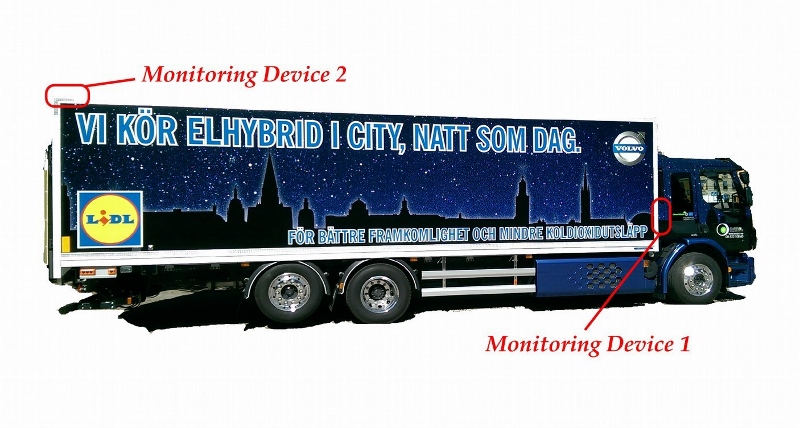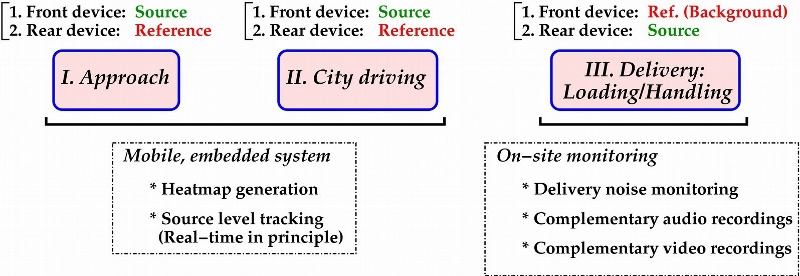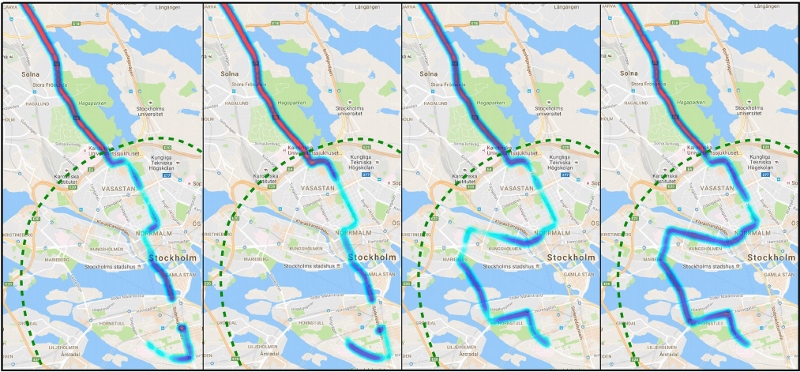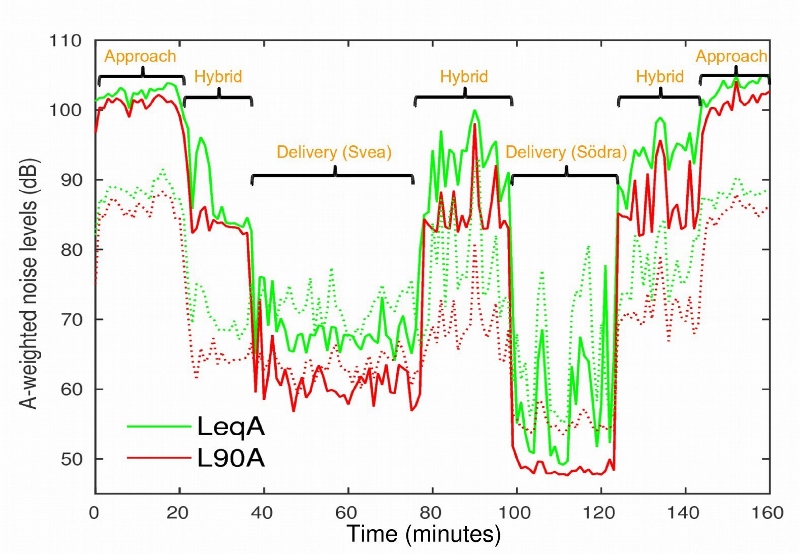Off-Peak Hours Deliveries: An Acoustic Perspective on the Stockholm Pilot Study
By Romain Rumpler, Ragnar Glav, and Peter Göransson
KTH Royal Institute of Technology, Stockholm, Sweden
Introduction
With continuously increasing urbanization and its associated impact on traffic congestion in major urban areas, a number of “off-peak” initiatives have been implemented over the past decade (see the list of references at the end of this article). Their aim is to shift part of the traffic to less congested periods. Of particular interest is the use of the nighttime window, virtually congestion-free, to respond to environmental considerations, economic opportunities, and the challenge of daytime congestion.
One difficulty with the implementation of off-peak hours deliveries (OPHD) is to convince all stakeholders—shippers, receivers, carriers, customers, and communities—of the cost/benefits trade-off, their distribution, and the potential incentives to be implemented.
The current situation in the City of Stockholm, Sweden, is a complete ban on truck deliveries during the night, between 10:00 p.m. and 6:00 a.m. Given the rapid growth of the city, Stockholm faces increasing congestion issues despite a considerable number of infrastructure investments. The municipality is therefore willing to evaluate the impact of potentially lifting the nighttime ban in the future, and a pilot study and report (Pernestål Brenden et al. 2017) have been made with the objective of identifying potential hindrances and benefits. This preliminary study, involving two heavy trucks (one hybrid electric and one biogas), focused on four aspects: transport efficiency, noise, socioeconomic analysis, and policy, combined with stakeholders’ perceptions.
Identified as a key barrier to the OPHD, the impact of noise emissions and the associated methodology used during this pilot study are partly reviewed in this article.
Methodology
There are three main configurations where noise emissions need to be evaluated in the context of OPHD and their potential nuisance for the citizens: noise emissions outside of the city center (that is, approaching the city via some type of limited-access road), noise emissions while driving in the city, and noise emissions upon delivery (loading and unloading).
For the purpose of assessing all three areas, the vehicles in the present study were equipped with onboard noise-monitoring systems, thus focusing on the source rather than the receiving end of the noise disturbances. For practical reasons a commercial off-the-shelf technical solution was implemented using noise-monitoring systems from Sonitus Systems, Dublin, Ireland. The output data was limited to equivalent sound pressure levels, statistical noise levels, and peak sound pressure level, with both slow and fast time averaging as well as A- and C-frequency weighting. A minimum of one-minute periods was available, while no frequency analysis was enabled at the stage of this pilot study.
The methodology adopted offers an alternative to the stationary approach used, for example, to map noise in the form of heat maps by shifting the emphasis to the source. The impact at the receiver end may then be obtained after postprocessing the source-related data. In order to be able to adapt the noise monitoring to two essentially different configurations—that is, driving or delivering conditions—the two trucks were equipped with two such monitoring devices each, as illustrated in figure 1.

Figure 1. Position of the microphones for the noise-monitoring devices mounted on the trucks. “We run hybrid electric in the city, night and day.”
The positions of these units, at the front (between the cabin and cargo space) and at the top rear, are intended to provide information in connection with the driving conditions, the background noise, and the delivery noise. The configurations associated with this hypothesis, tested in the scope of the pilot study, are presented in figure 2.

Figure 2. Methodology for qualitative noise monitoring in all three configurations: long-distance or country driving, city driving, and delivery.
As an example, in a delivery configuration (identified as a fixed location of the truck and an engine turned off), the rear monitoring device will capture the noise associated with the handling of the delivery goods, while the front unit is intended to provide information on the surrounding background noise in the delivery area.
Sample Results
The monitoring of running vehicles is illustrated in the form of source-focused heat maps, in principle real-time, as in figure 3 for the hybrid electric truck. The delivery routes to the same location are presented for four different nights, all around 3:00 a.m. For these plots, the absolute level from the front unit, without postprocessing accounting for the rear unit, reflects the levels of noise mostly radiated from the engine. The following may be highlighted:
- The effect of switching to the electric engine when entering the inner city, past the green-dashed line (in particular in the first three plots)
- The obviously defective switch to electric mode (last plot)
- The occurrences of switching back from electric mode (sharp acceleration after traffic light, high speed zones such as bridges, etc.)
- Operator-specific driving behavior and the associated comparison of delivery route choices

Figure 3. Comparative journey to the same delivery point, around 3:00 a.m. on four different days. Green dashed-line delimiting the city center. Qualitative legend from red (high noise emissions) to light blue (low noise emissions).
The three configurations introduced in figure 2 are detailed in figure 4 on a sample time-averaged monitoring of a complete delivery route: warehouse to two delivery locations (inner city) and back to the warehouse outside of the city.

Figure 4. Averaged-levels monitoring for a complete delivery route, front device (–) and rear device (···).
The three phases are very distinct:
- Approach: High noise level at the source (front device), also captured by the rear unit, reflecting the high driving speed on a limited-access road to and from the city center, with the combustion engine.
- Inner-city driving: Switch to electric mode while the driving speed is also reduced, triggering a noise reduction of about 17 dB(A) on average at the source. Noticeably, the noise level from the source is only slightly captured by the rear device above the surrounding background level.
- Delivery: The front device provides a very good reference level of the background noise surrounding the delivery location, while the rear device monitors the delivery noise. A further derivation provides a noise impact measure of the delivery by a differential indicator between the front and rear units. In particular, in the example provided in figure 4, the second delivery location (“Södra”) is obviously a much quieter place by nature, which, somewhat paradoxically, makes it a questionable candidate for OPHD if it also corresponds to a densely populated residential neighborhood.
Conclusions and Ongoing Work
The methodology based on the use of two monitoring devices placed directly on the mobile source (delivery trucks) provides insight into noise generation for the complete delivery route. Further investigation may enable a permit-based authorization for OPHD, a solution currently considered in lifting the total nighttime-delivery ban in the city of Stockholm. It offers the possibility both to dynamically select suitable locations for OPHD and to monitor noise emissions upon allocation of such permits.
In order to bring the concept to a systematic methodology, a continuation of this pilot project, in the scope of the EU project ECCENTRIC, is currently running with increased capabilities, in particular aiming for an extensive amount of measurement data with refined postprocessing possibilities (time-domain, spectrogram, etc.).
Acknowledgments and Further Details
This project has been funded by the Vinnova program FFI (project no. 2014-05598 and 2015-02338) and has been coordinated by ITRL Integrated Transport Research Lab at KTH Royal Institute of Technology.
Partners involved in the pilot study include the City of Stockholm, Svebol Logistics AB, Lidl Sverige KB, Martin & Servera AB, K.Hartwall Oy AB, Scania CV AB, AB Volvo, and Chalmers.
The Centre for ECO² Vehicle Design (KTH, Stockholm, Vinnova grant 2016-05195) is also gratefully acknowledged for its financial support of the authors.
Off-Peak City Logistics project in Stockholm: http://www.itrl.kth.se/research/projects/off-peak.
EU project CIVITAS ECCENTRIC: http://civitas.eu/eccentric.
References
Chicago Metropolitan Agency for Planning. 2008. Go To 2040 Comprehensive Plan.
City of Seattle. 2008. Seattle Urban Mobility Plan.
European Local Transport Information Service. 2015. “Silent Inner-City Overnight Deliveries in Barcelona (Spain).” http://www.eltis.org/discover/case-studies/silent-inner-city-overnight-deliveries-barcelona-spain.
Holguín-Veras, J., C. Wang, M. Browne, S. Darville Hodge, and J. Wojtowicz. 2014. “The New York City Off-Hour Delivery Project: Lessons for City Logistics.” Procedia—Social and Behavioral Sciences 125:36–48.
McPhee, J., A. Paunonen, T. Ramji, and J. H. Bookbinder. 2015. “Implementing Off-Peak Deliveries in the Greater Toronto Area: Costs, Benefits, Challenges.” Transportation Journal 54 (4): 473–495.
Pernestål Brenden, A., A. Koutoulas, J. Fu, R. Rumpler, I. Sanchez-Diaz, S. Behrends, and M. Brolinsson. 2017. Off-Peak City Logistics—A Case Study in Stockholm. Sweden: Integrated Transport Research Lab, KTH Royal Institute of Technology.


